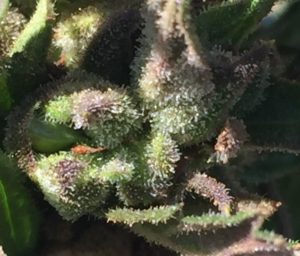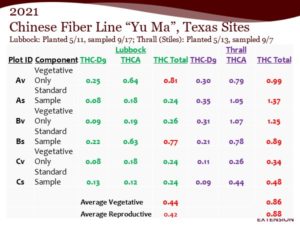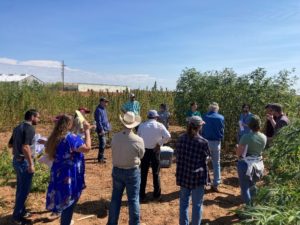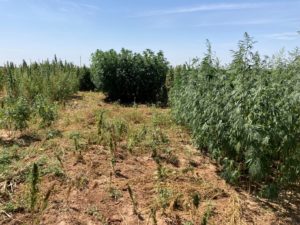Dr. Calvin Trostle, Professor & Extension Agronomist/AgriLife State Hemp Specialist, TAMU Dept. of Soil & Crop Sciences, Lubbock, (806) 746-6101, ctrostle@ag.tamu.edu
We continue the statewide Zoom updates we began in March. The September update will be Tuesday, November 2, 5:15-6:30 PM Central Time. We will not meet in December but resume in 2022 on January 4.
October topics will largely follow this newsletter. And there will be plenty of time for discussion.
To join use:
https://agrilife.zoom.us/j/94133207184?pwd=dDdRT0Q0ZkVRV1M3VW5vUzVLanBIQT09
This month’s meeting does not require registration.
Observations of Trichomes in CBD Hemp
I have a question for our growers. I record trichome color (amber, milky, clear) when I collect samples for CBD/THC analysis. I get seed in my CBD trial as two of four varieties are straight run seed for CBD anyway. I am amazed at the trichomes on the “glumes”‡ (that is what I call them) that enfold each seed (Fig. 1, a stock photo likely of an unpollinated female). Those structures exist in unpollinated floral structures, too, which is where the CBD and other cannabinoids are present. This is the heart of most CBD production to date from female production. The glumes likewise are present in unpollinated female floral structures, there is no seed inside. I was struck this past week how many and full looking these trichomes were where there was seed.
Fig. 1. Trichomes on female hemp floral structures including “glumes” that enfold any developing seed if pollenated. (Stock photo.)
I don’t have any unpollinated CBD hemp here at Lubbock to compare. So, my question for growers: if you are able to compare glumes for pollinated (have seed) and unpollinated CBD hemp, do you notice any possible difference in the number or ‘fullness’ of trichomes on glumes with and without seed? I am guessing that the glumes, whether they are pollinated and enfold a seed or not, would be the same. But do they respond differently?
On the same varieties I am studying I have also been impressed with the number of trichomes on the sugar leaves emerging from the cola.
‡Per the discussion about the female floral structures and glumes (this term is used in other crops like wheat and grain sorghum), maybe that is not the right word. If you have a good document or reference that has helped you understand Cannabis growth and development and describes the plant physiology, please share it with me. I will look through your suggestions and choose a couple of good citations to share in the January hemp update.
“Yu Ma” Chinese Fiber Variety Grows Well but is Hot for THC—Even in the Vegetative Stage
I discussed fiber variety Yu Ma in my October Zoom update. Samples of Yu Ma from Lubbock and Stiles Farm (Williamson Co.) have tested from 0.4 to 0.8%, on average, for THC (Table 1). In some of these samples there were no reproductive structures (Fig. 2). Comparisons have included vegetative only vs. samples that had some male reproductive growth (Fig. 3). No sample contained any female reproductive structures. (Tests that do are awaiting chemical analyses.)
This came as a surprise. In 2020 another Chinese fiber variety, “Jin Ma” tested hot (1.14% THC; the other five fiber varieties tested ≤0.07% THC) in our official sample in Lubbock AgriLife’s hemp fiber trial. In China low THC at the level U.S. federal law stipulates for legal hemp (≤0.300% THC) is not a significant regulatory concern. They do not screen for low THC.
Fig. 2. Chinese hemp fiber line Yu Ma with normal growth relative to photoperiod at Lubbock, TX. No reproductive growth visible, Sept. 2, 2021.
Table 1. High THC is found in standard samples (some male reproductive growth and undifferentiated terminal growth, which is still vegetative) vs. vegetative only terminal growth. No female reproductive growth was present. This data suggests, in spite of Yu Ma’s good germination, seedling vigor, and normal reproductive growth (no premature flowering), the variety is not viable for Texas hemp production. (Source: October 4, 2021 “First Tuesday” AgriLife hemp Zoom update.)
By current law the above hemp samples over 0.3% THC (plus experimental error, in this case about 0.02%) must be destroyed.
The formula which hemp labs use to calculate total THC is:
%THC (Δ9) Total = %THCΔ9 + (0.877 X %THCacid)
Δ is the Greek symbol ‘delta.’ This equation includes the acid form of THC, often called THCA, which can naturally convert to delta-9 THC through a chemical process called decarboxylation. By law, THCA must be included in total THC. Note that total THC does not include delta-8 THC (see below for more about delta-8).
Fig. 3. A closeup of male reproductive growth that was observed on Yu Ma at samplings on Sept. 17, 2021.
Texas A&M AgriLife Hemp Trial Work—Lubbock, Thrall, Weslaco
Several small trials are in place:
- Fiber variety trial, Lubbock. The field trial is retting though we have had no rain for several weeks since cutting. A few varieties will also be measured for grain yield. Five of 13 varieties were bagged without retting due to little to no growth (northerly lines, flowered prematurely hence little growth). We covered the plots that included grain measures to protect from birds.
- Planting date trial for fiber varieties. The June, July, and August planting dates generated few plants. Was the soil too hot? The April and May dates generated good data on initial reproductive growth.
- CBD trial. I have four varieties, and like last year a poor stand. Three samples were collected over time to gauge changes in CBD and THC with time. Samples have been stripped for collection of floral structures.
- September planting of hemp fiber lines. Weslaco and Stiles Farm (Williamson Co.). Hemp fiber lines EcoFibre ECO-MS77 (Australia), Yu Ma, and Eletta Campana & Fibranova (Italy) were seeded to observe when plants enter reproductive growth. One variety (MS77) has been suggested for possible winter growth in far South Texas. So, remaining in the vegetative stage—and potentially averting longer dark period control of reproductive growth—and growing in cooler conditions will be observed for crop performance.
I shared a picture of the Lubbock fiber trial taken in late September with the October First Tuesday hemp Zoom update. The pic is labelled to identify the great range in growth observed among fiber varieties (Fig. 4).
Comments from the September 27 & October 8-9 Hemp Field Programs
Field programs were held September 27 at Lubbock, October 8 at Chillicothe, and October 9 at Muleshoe. These meetings generated little interest among farmers and prospective growers. Some industry individuals attended, Texas Department Ag. brought 16 field staff to the Chillicothe meeting, and the Bailey Co. sheriff also attended at Muleshoe.
The Bailey Co. site was implemented by Andrew Bish, Bish Enterprises, in Nebraska. It is one of at least nine sites planted across mostly the southern U.S. It features prospective fiber lines. European fiber lines (mostly France?) Fribror 79, Felina 32, and Futura 75 are include, which are not in any Texas A&M AgriLife trials. None of these three varieties, in spite of being promoted as potential hemp fiber lines for the southern U.S. grew well. They appear to have flowered prematurely and had poor growth. Other southerly locations will be evaluated for similar results.
Most of the discussion apart from explaining hemp growth and development and fiber varieties revolved around potential for further market development in Texas, especially fiber.
Fig. 4. Labelled varieties from the Lubbock hemp fiber trial demonstrating a huge range in growth (or lack of).
Texas Department of Agriculture Hemp Reminders
TDA reminds licensees to be sure to file your lot crop reports.
In the original development of rules, no state wanted hemp regulations to be unnecessarily punitive. TDA notes that some rules for hemp are evolving as the industry and regulatory agencies gain experience with the crop. Also, situations arise which none could have foreseen. One area of thought is the possible remediation of hemp crops if THC > 0.3%. This is one area of possible discussion moving forward.
Further Status of Delta-8 THC in Texas
Since the August newsletter delta-8 THC has been in the news including statements that this cannabinoid is a Schedule I Controlled Substance and is banned in Texas. I am asked about it frequently. First, my focus is on field agronomy, how to grow, what varieties to try, how we can improve the sampling procedure in the field for your official THC test, etc. So, for that reason issues surrounding delta-8 THC are not of immediate effect to me in my role for Texas A&M AgriLife Extension. Yet there are many potential implications of restriction and ban on delta-8 THC. I am as interested as you are in learning about this.
If you are not yet aware of questions surrounding delta-8 THC articles in the Houston Chronicle, Texas Hemp Reporter, and Texas Tribune do a good job explaining the issue.
The field question I am asked is: “Will the potential and apparent regulation of delta-8 THC affect farmers and having a market to sell to?”
Immediately, there still appears to be an over production of CBD, so D8 being banned would not change that. Growers at any scale from small to large may think merely “I grow for CBD, so it does not matter to me.” A market that uses CBD for conversion to D8 would reduce the oversupply. So, in time that would potentially catch up and might increase demand for CBD. But of course, there are some major “ifs” on this question.
At a minimum any grower, processor, or retailer that is relying on delta-8 THC for their market and business is taking a risk for the time being until this issue is sorted out through possible court action. The current legal position in place at the moment is delta-8 THC is banned in Texas. In the past couple of months a few additional states have acted against delta-8 THC, either wholly banned or possibly just regulate. If the courts find that the language in the Farm Bill and subsequent federal and state rulings and interpretations was not clear and delta-8 remains available, that may only be temporary until legislation, re-clarification, re-issue of interpretation, etc. occurs.
Upcoming Texas A&M AgriLife Extension Hemp Programs
Amarillo Farm Show. I will be speaking as a member of a panel on industrial hemp on Wednesday afternoon, December 1.
December Hemp Zoom. Due to travel we will not hold the December hemp “First Tuesday” hemp Zoom. We will resume Tuesday, January 4, 2022.
Ongoing Texas A&M AgriLife Extension Hemp Resources
General Information
We continue adding resources at http://agrilifeextension.tamu.edu/hemp including under ‘Hot Topics & Latest Updates’ on the main page.
Hemp Plant Disease Diagnostics—Texas A&M AgriLife @ Amarillo
Download the needed hemp-specific form from https://thppdd-lab.tamu.edu The policy for hemp diagnostics and collection/packaging/submitting plants is on the back of the form. It is best to notify Dr. Ken Obasa in advance of sending samples, office 806.677.5600, ken.obasa@ag.tamu.edu In fact, you may e-mail digital images first which might provide a diagnosis and save the transport permit and diagnostic fees.
Texas A&M AgriLife Hemp Potency Testing for THC & Cannabinoids
Sample analyses of hemp for THC and cannabinoids is available through Texas A&M AgriLife labs at Uvalde and Lubbock. College Station will be added soon. The labs are now equipped with an auto sampler which greatly speeds analysis of large sample sets. For further information consult http://soiltesting.tamu.edu/hemp.html This service is not currently for official THC analyses required by law.
Our Hemp Program Twitter Account
@TXAgriLifeHemp
Video Series: Economic & Legal Considerations for Hemp Production in Texas
This series of 29 videos is available at https://agecoext.tamu.edu/resources/legal-and-economic-considerations-for-growing-hemp/ Topics cover legal, contracting, economics, and potential crop insurance. The website is divided into the sections below. Choose the YouTube video you want to see and also the slides for each presentation (3 to 15 minutes).
Do you have hemp questions?
Find regional and topical Texas A&M contacts for hemp at https://cdn-ext.agnet.tamu.edu/wp-content/uploads/2020/02/AgriLife-Hemp-Resources-Personnel-2020-02Feb10-Trostle.pdf
If you have a question that we can include in our Twitter communication, via this newsletter or the First Tuesday updates, please e-mail Calvin Trostle.





